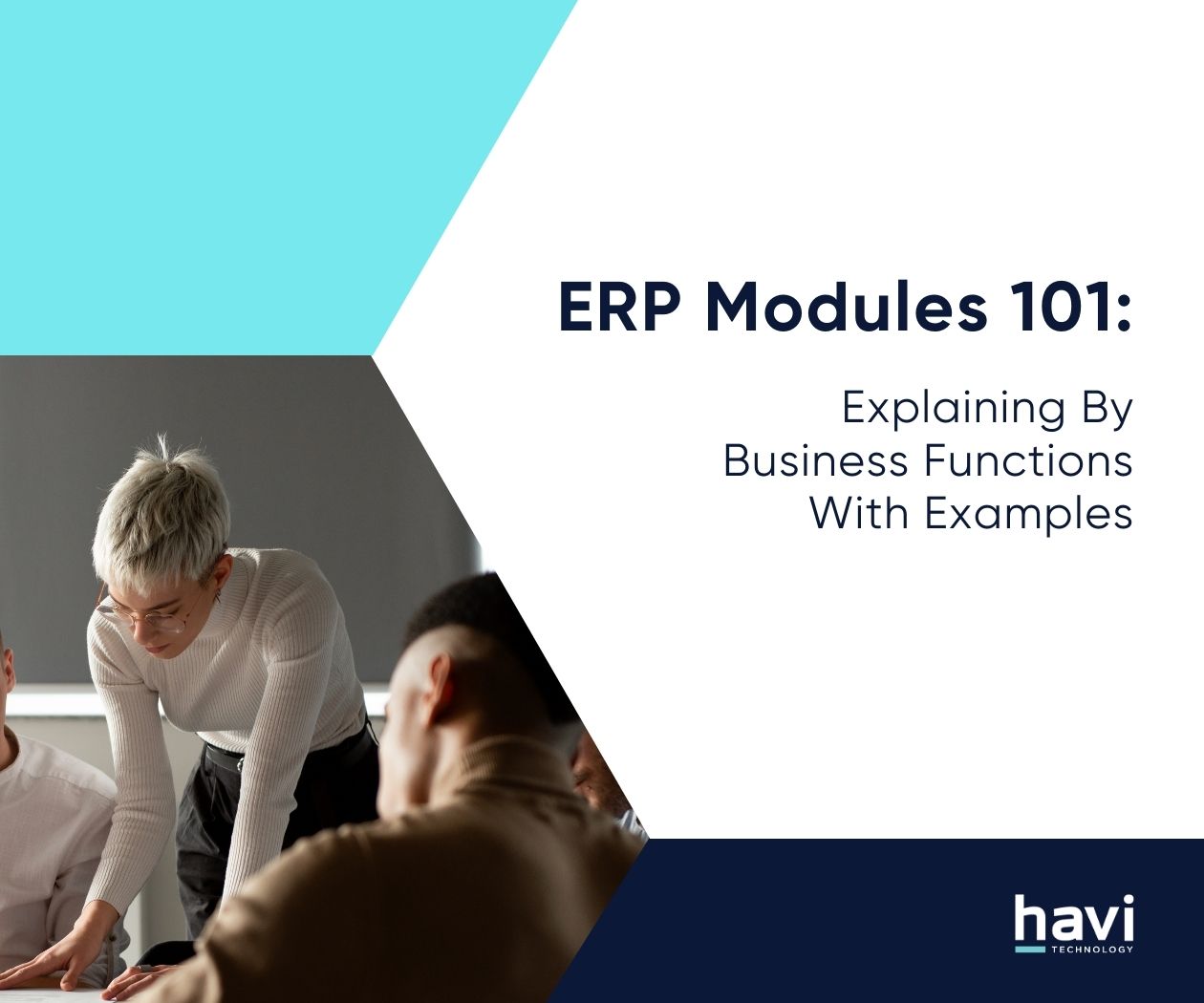Want to see how Havi can help with your ERP software implementation?
Let our dedicated team support you every step of the way.
Thank you for messaging us
You message has been sent.
We will get back to you shortly.
You might also like
Selecting distribution ERP software is not a simple task. Like any other industry, the distribution ...
ERP consulting services - Do you need them? An ERP project is more complicated than just taking a lo...
ERP functionality is structured based on distinct capabilities, which are commonly called ERP module...





Orders are piling up, delivery is running late, and constantly dealing with inventory problems - in this case, you're not alone, which is why a lot of companies are moving to ERP for supply chain management.
This article is your ideal road map to simpler ERP selection. We'll delve into supply chain ERP, exploring its advantages, and guiding you to choose the best solution.
How An ERP Contributes To Supply Chain Management
1. Defining ERP for supply chain
An ERP (Enterprise Resource Planning) system provides a centralised data hub and integrates its key business operations across departments. Not only finance, sales, human resources, or marketing, the system also delivers an extensive set of features to optimise every phase of a supply chain lifecycle.
Using an ERP system to manage and optimise the supply chain offers multiple advantages such as:
Integration capabilities are the building blocks of an ERP system's performance. These features share data and functionalities seamlessly because they are ''integrated' modules - not separate elements. For example, the production planning and inventory management modules of an ERP are automatically connected so that users can easily adjust production schedules based on existing inventory levels. This ensures no data silos and a comprehensive supply chain overview.
Learn more about:
2. Supply Chain Management (SCM) vs ERP Systems
Whether an SCM system or ERP for the supply chain is best will depend on your business demands. An SCM system might be perfect if optimising particular supply chain functions is your main goal. However, an ERP is a better option if you’re aiming to integrate your supply chain workflows with other core business functions, streamlining the entire operations. Many growing companies now utilise the advantages of both systems by integrating the SCM into their ERP.
Supply Chain Management (SCM) System
Enterprise Resource Planning (ERP) System
Focus
Streamlines supplies, materials, and data movements for the entire supply chain
Integrates and controls all essential business operations
Features
Specialised features: supplier relationship management, logistics management, demand planning, etc.
Essential features: production scheduling, inventory management, purchasing, and others such as finance, sales, etc
Data Management
Supply chain management- specific data: supplier performance, inventory levels, logistics movement, etc
Organisation-integrated data such as finance, sales, marketing, procurement, inventory, human resources, etc
User Interface
Customised for Supply Chain Professionals. Non-specialist users may find the interface less user-friendly
A consistent and friendly interface that is easier for individuals from different departments to navigate and utilise
Overall Impact on Business
Enhanced supply chain productivity, shorter lead times, greater inventory control, or better supplier engagement.
Enhanced overall business performance, more cost-effective operations, better visibility, and higher customer satisfaction.
4 Stages To Select An ERP For Supply Chain
It is important to select the right ERP for the supply chain to maximise productivity and fulfil your business demands. We break down the main steps in the selection process as follows:
Step 1: Taking notes of essential features
First, determine what features are must-haves in your supply chain ERP system. Consider the following features:
Demand Planning
The capability to precisely predict customer demand while considering market trends, fluctuation, and historical data. This helps optimise production scheduling & inventory levels
Manufacturing
Controlling production procedures such as capacity planning and bill of materials (BOM) management efficiently. This helps users guarantee on-time delivery
Warehouse & Inventory Control
Offering effective picking, packaging, and shipping methods. This helps gain real-time visibility into stock levels across warehouses and optimise them to reduce storage costs and shortages
Logistics Integration
Seamless integration with your favourable logistics solutions such as warehouse management systems (WMS). This helps to provide a more complete view of your supply chain
Order Management
A full-featured system that handles everything from order entry and fulfilment to tracking and handling customers' refunds
Product Distribution
Last-mile delivery tracking, logistics management, and route optimisation tools. This helps control and streamline the flow of inventory from storage to distribution points and end customers.
Procurement
Monitoring supplier performance and relationships, and automating purchase orders. This helps streamline the sourcing process.
Step 2: Analyse your business scenario
After you have identified all the essential features, investigate your business setting. With an in-depth evaluation of your business conditions, you can figure out exactly what you need and make sure the selected ERP can help solve your supply chain issues. Here are a few important areas to look into:
Step 3: Understand what ‘fit’ to your ‘gaps’
This phase requires connecting the gaps in your current supply chain procedures in Step 2 with the ERP features that have been identified in Step 1. Discuss with key personnel to analyse how desired supply chain ERP features align with the unique problems you have and fill in the gaps.
Step 4: Craft your ideal solutions & evaluate best-fit vendors
Based on your findings, create a document that describes your desired ERP solution and develop a Request For Proposal (RFP) based on your findings. In this document, list all the ERP capabilities you need for every aspect of your supply chain. Then, create a shortlist of vendors who provide solutions that closely match your requirements based on the RFP.
When evaluating vendors, consider these areas:
These four stages set a great foundation for selecting an ERP system that meets your supply chain management requirements. Note that the perfect ERP system should not only meet your current needs but can also evolve and expand with your company in the long term.
Top 3 ERP Vendors For Supply Chain Management
Dynamics 365 SCM
Dynamics 365 Supply Chain Management (SCM) is an enterprise supply chain ERP solution developed by Microsoft. It helps operations professionals to transform their manufacturing and supply chain workflows. Dynamics 365 SCM offers a central location for business analytics, leveraging predictive insights, AI intelligence and the Internet of Things (IoT) across the entire supply chain. This enables users to optimise operational efficiency, product quality, and eventually, profitability.
Odoo For Supply Chain
Odoo is an open-source ERP that centralises every function of a company's operations in one single location. With a high customisation capability, it lets you easily configure and customise the supply chain management workflows. Moreover, Odoo has a modular infrastructure where dedicated modules such as Inventory, Material Requirements Planning (MRP), Purchase, and Finance integrate seamlessly with each other. This offers businesses complete visibility and control over their entire supply chain.
SAP S/4HANA Cloud
SAP S/4HANA for Supply Chain Management is a cloud-based ERP with built-in intelligent technologies for complex business processes. Most enterprises utilise SAP to streamline their supply chain management, from the order production process and managing inventories to fulfilment and deliveries.
Have A Great Start: Conducting Your ERP Demo
From our experience, conducting a demo for ERP in your supply chain is the most valuable and practical approach to seeing the system in action. This can help you quickly determine if it is the right fit for your supply chain.
We highly recommend you request a custom demo that illustrates how the chosen system handles your workflows and difficulties. Don’t forget to involve key personnel in the evaluation so that the final option will satisfy everyone's demands.
ERP Supply Chain - Frequently Asked Questions
1. What is CRM and ERP?
Both ERP (Enterprise Resource Planning) and CRM (Customer Relationship Management) systems help streamline business operations, but each aims for different objectives. CRM helps manage your customer relationship and generates all customer-related data in one location. Its final goal is to streamline processes in the customer journey, such as sales, marketing, or customer support. ERP centralises your key operations data in one place. ERP gets data from various business functions such as supply chain, human resources management, accounting, or marketing. Learn more: ERP & CRM - Differences & Integration.
2. Are ERP and SCM the same?
Both ERP and SCM systems can help your supply chain to operate efficiently, but each of them has a different focus on business functions. ERP integrates organisation-wide data, from supply chain, manufacturing, and sales, to marketing, human resources, and finance. SCM systems focus on supply chain data, such as stock levels, order processing, suppliers or logistics metrics.
3. What is an ERP system example?
Odoo and Microsoft Dynamics 365 are examples of ERP systems with integrated features that help businesses streamline operations, improve productivity, and accelerate better decision-making.